
The time in Brooklyn is now:
Wed Jun 11 23:27:51 2025


We endorse the greatest
health and beauty products
and shampoo on the
market -
Maple Holistics
Since I have been 9 years old I have been reading and collecting comic books. I have read just about everything from Platinum Age until now. This covered such strips as the turn of the century work like Windser McCay's Little Nemo in Slumberland, though to the modern era gems like Brian Woods' Local.
I started this life long passion by hocking the local newspaper, The Canarsie Courier at the Rockawy Parkway Train Station on the LL line, earning spare pennies. Not long after I had noticed that the corner newspaper stand on Glenwood Road and Rockaway Parkway had a comics rack. There I grabbed my frst books in exchange for my hard earned pennies, often reading books before school over an ice cream soda. In this way, I flt, even as an opharned child, connected to a larger universe, and the City of New York. And I was.
Over the history of Comics, there has been several transformative or watershead moments. Sometimes they are brought about by a single book; by the vision of an individual author. Sometimes important series or events are the product of an effort of an entire editorial team, such as the work the EC comics team which has helped define a new genre. Such influential works include George Herriman's Krazy Kat, Frank King's Gasoline Alley, Shuster and Siegel's Superman, Kirby and Lee's Fantastic Four, William Gaines and Harvey Kurtzman, in the Tales of the Crypt and Mad Magazine, and that is not a complete list.
By the late 1970s, the comics business was reeling. For all its success, Marvel comics was near bankrupcy in the mid-1970s. The firm was virtually and famously saved by the Star Wars adaption done by Howard Chaykin and Roy Thomas. Newspaper stands sales was drying up. Saturday Morning Cartoons had overtaken comics for the interests of little boys and girls. The teen market was all but squashed by congressional censorship efforts in the 1950's. New urban patterns of travel and work put pressure on the newspaper, magazine and comics business.
Entering into this, by the 1980's, a new and untapped market was developing, and I can best explain this through personal experience. In the later 1970's, I found a new venue for my Comics reading habits. Jerry Kanowitz, and his wife, Harriot, opened a back issues comic shop on Rockaway, Parkway, past the fire station near Foster Avenue. Jerry was one of the first owners of a comic book shop, and he had deep connections within the publishing business. Aside from bins upon bins of back issues, Jerry had a steady supply of key issues that hung on his wall. In those early days, it would not be unusual to see an Amazing Fantasy #1 on the wall, along with Avergers 1, Captian American 100 and Avengers 4, early Hulks and Iron Man apearances, along with DC Showcase 4, and 22. Neil Adams' Batmans were popular at the time, and a lot of neighborhood kids turned Jerry's place onto a hangout. More than just a comic store, for guys like Frank, Rizzo and myself, it was the neighborhood safe house.
By 1976 the comic convention had become a regular goto event. Jerry's gang was exciting to go the Hilton Slatler Hotel for the big convention. We had never seen so many comic fans in one place before, and we were all autograph hounds. My friend Frank got Neil Adams to sign about a dozen books and declared so in his excitement. He was then lectured by Adams, telling him, what happens to all the people I can't get to because I ran out of time. It was all in good natured fun at the time and not a terrible way of burning a childhood.
Jerry eventually moved to Avenue M, near Bildersee JHS. I went on to College. Just before I left for school in 1983, I picked up a few new kinds of books, unlike anything I had seen before, from the news stand at the Junction in Brooklyn, at Avenue H, and Nostrand Avenue. I picked up Ms Tree, John Sable, and American Flagg!! These were the first independent comics I ever read. The work was all fresh. But of all the work done at that time, American Flagg!!, by Howard Chaykin was unlike any comic yet published for the mass market. It was heads and shoulders above the rest. This was the magic year of 1983, which is the year that is now commonly referred to the year when the Modern Era of comics was born, and American Flagg! was largely responsible for coalescing the new movement.
While events were slowly building toward the modern era, by 1983 all the necessary elements for exploiting the new comics market were in play. Through the years, slowly the collectors market had been brewing. Jannette Kahn, on taking over DC had tried to collect talent by offering royalties. Distributors were brought on board to bring direct sales to specialty stores. Both DC and Marvel had decided to carve out the back issues market by flooding the stands with new titles and talents. Experimentation and adult story lines had slowly developed. Before 1983, the most breakthrough title was likely Neal Adams and Dennis O'Neil Green Lantern/Green Arrow series that closed out the Green Lantern silver age series, which ran from issue 76-89. This series that ran from 1970- 1981 covered much of the troubling issues festering in the national conscious for nearly a decade. The target audience was clearly more adult. And that adult market was converging on back issue stores, "Comic Shops". Comic Shops where increasing market to by bringing new titles which opened up opportunities for moderately funded, talent driven and creator owned companies. One such company was First Comics, which was out of the Chicago Suburb, Evanston, Illinois. First released to the direct market American Flagg!!, The Badger, E-Man, Dreadstar, and Jon Sable. Somehow these also made it to the newspapers stands. But the First title that got on the national radar was American Flagg!!
Despite the growing trends, it was hard to anticipate the arrival of American Flagg!! Chaykin, though well know for his Star Wars work, had never delivered anything with the skill and development that American Flagg!! had. It was difficult to look back on Chaykins career up to that point with anticipating for this kind of enormous breakthrough. At this time, I had never heard of him and had to research his work after the first issue was released. He did a minimal amount of Superhero work. He did some minor work in Sci-Fi. His Star Wars work, to my eye, was merely adequate for the task. But American Flagg!! was bolt from the blue.
The craftsmanship was unlike anything else I could remember seeing in a standard comic format. Every panel was thick with detail. The standard 17-25 page comic might take 20 minutes to read. American Flagg!! read like a literary work, taking over 2 hours to work through a first reading. The book was always delayed in its release, which added to the anticipation, awaiting for the next issue to hit the stands. The story telling wasn't in any way rushed. It unfolded in a natural way, spending nearly 3 pages on the uneventful flight from Mars to the Chicago Plex, which did nothing for the storyline other than set the tone and feel for the rest of the series. The main protagonist, Reuben Flagg, doesn't show his face until page 5. From that point on, however, a bewildering number of characters make there appearance, giving a feel that I only again experienced in the opening scenes of "Lost in Translation" when Bill Murray is surrounded by smiling helpful Japanese faces who he can barely record in the stuper of his long trans-pacific flight. Flagg and the reader is likewise surrounded by a bunch of unfamiliar and unknown names and faces. Slowly the players come into focus. Hammerhead Kreiger and his daughter Mandy take center stage. Gretchen Holstrum, Raul the cat, Representative Klein-Hernandez, Charles Keenan Blitz, all soon take the stage. It's a big cast, and it grows bigger over time. I had to write the names of the characters on a peice of paper in order to keep track.
It's been said that Carmen Infanano was famous for his page layout and design. He taught page design in New York's the School of Visual Arts. But Carmen Infantino was second seat to Howard Chaykin. Chaykin's page design was revolutionary. His partner in this was his letterer, Ken Bruzenak. Through page design, he adequately told the 30 year history of the Plex on the single page, page 17, of the first issue of Flagg!! Panels bleed into each other and the order in which they are read become optional, adding to the feel of chaos to the stories, drawing the reader into the process of creating chaos. Chaykin slows time and speeds it up at will, creating a background of tension and surprise.
Flagg hit the American Comic book creative community like one of his Gogang attacks.
Chaykin's work was revolutionary on several levels, and an analysis and break down of these aspects of his work in a
methodical. Let's explore Chaykin's work through the lens of these aspects of
his creative genius.
Continued Below
Chaykin presents us with a rich storytelling technique which was novel to comics up to that time. The stories had several multiple inter-threaded storylines that intertwined with each other, interceding at multiple climaxes separating different aspects and moments as they were being explored. Chaykin drew from a rich history of science fiction, mystery, spy novels, and even Greek theatrical tradition. He wrote a "bible" which was supposed to be consulted and adhered to in developing plot and dialogue, and this contributed to the richness of the reading experiences.
The first 12 issues were a complete cycle, whose focus was the attempt to kill the population of Chicago by a highly organized Nazi political group that had infiltrated the existing Mars central Plex government. Within this cycle the story has 3 internal threads that join together to reach the crescendo in 12th installment. It was released originally as a monthly serial, so each book had its own additional storyline that was worth spending you dollar on. The cadence of the story worked out as follows:
The first 3 issues introduced the world of the Chicago Plex and centered on the murder of Q-USA's ownership, Hilton Kreiger. It climaxes with the death of a Plex investigator with fascists leanings who learns about QUSA and attempts to kill Flagg. The cycle ends with Reuben Flagg in procession of the illegal media center(Q-USA). In the process most of the major characters of the book are introduced, and given life. Relationships, political alliances, romances, and competing interests are established and lay the table for the buffet of storytelling to come.
Issues 4, 5 and 6 introduced a new cycle of connected story with Reuben Flagg following the origins of a subversive subliminal video feed coming from Brazil. He travels under the guise of guarding an illegal basketball to matches in Havana and Brasilia, and to participate in a convention for fellow Plexus Rangers which includes an exhibition of firearms and weaponry for law enforcement. While on this trip, Flagg foils a hijacking, takes a tour of the back waters of Havana, and extracts his basketball team from a riot. They continue to Brasilia and follow the signal to the local mall, overcome two assignation attempts on Reuben's life by an arm of the radical group that is putting out the subliminal signals. The result leads to the signal coming straight from the Rangers office, and leads to suicide of Emet Golem, the Ranger of Brasilia.
Issues 7,8 and 9 centers on an artificially produced blizzard that puts Chicago and the Midwest into a full crisis. Massive movement of homeless people are being sheltered in the Plexmall. The background of despair and human displacement leaves the Chicago mall population in conflict with the interlopers. And the migrant population that has reached the mall are hardened, and often violent, looking for people and places to lay blame for their troubles. Tolerance is reduced, and conflict bubbles over among the populations in and about Chicago. The mayhem also mobilizes the radical groups that surround Chicago and that pumped in subliminal feed into Plex programming. We watch the core of Chicago government slowly collapse and an attempt to sell the Midwest to Four World Industries of Brazil. The cycle ends with the resurrection of the Nazi Plex investigator who tried to assassinate Flagg in the first cycle, and his upsurging Chicago government with a Fascist government.
The final cycle ran through issues 10 to 12 which brings a stunning climax to what was a years work. Nazi's take over the Chicago government and threaten the foundations for every Democratic resistance, and threatens mass-genocide of the entire Chicago Plex mall population. Flagg has to clobber together a resistance that largely consists of policlub villains supervised by the members of the illegal basketball team, to win back the mall and end the massive gassing of all the Plex Chicago residents. All the characters of the drama seemingly weave through their individual webs, all converging at the crucial moment for a crescendo of an unexpected action packed finish. The final segment, issue 12, has no less than 16 major characters in it, including, Reuben, Mandy, CK, Raul, Luther, Gretchen, Bill, Harris, Titania Wise, Medina, Scheiskopf, Crystal, Esther Maria De La Cristo (who is actually dead), Desiree Overholt, Cyril and Jules, who makes an appearance on the cover as well. It has more fictional characters than a Jan Steen celebration. Each of these character have real life and dimension, individual storylines, and placed purposely into the scene to fill a determined message.Chaykin's handling of the story, with all of his characters, is a virtuoso writing performance as if he is conducting a 40 piece orchestra. Every character has been given enough development so that when they appear in the finale, they enter the stage fully enough fleshed out that the audience knows them like neighbors. They seem to act natually even within the context of a fantastical comic book. Their entrances and exits seem almost choreographed like a Broadway musical, not that dissimilar to the school auction scene in the musical "Oklahoma". That scene serves as the backdrop for all the competing interests, individual storylines, and reconciliations of grievances within the play. All the motivations based on historical conflicts, personal debts, social standings, courtship conflicts, and individual desires drive the play converging at the schoohouse auction schene forming the climax of the play. And like that classic scene in Oklahoma, all of Chaykin's characters enter into the finale with their own motivation and individuality, and leave the ending, each individual changed because of the turn of events.
American Flagg! broke new ground for comic story telling by using literary themes more often associated with science fiction and other literature rather than that of mainstream comics. Standard comics, particularly from the two mainstream outlets of DC and Marvel Comics, had a principle that anyone starting at any issue could read and understand all elements of the magazine title. In essence, any issue was a jumping in point for new (and young) readers. While there were advantages to this methodology for the publishers, this method reduced flexibility for the story writing. In American Flagg! this method was transformed. The innovative video news "flash" that is near the top of most issues was largely an ingenious means of working such principles into the main loop of the story, but the rigorous enforcement of this principle was abandoned.
This opened Flagg! for a much grander and complex story, one that really could not be summed up in a editorial notation, and allowed the plot to develop more like a novel. The result was that the book was nominated for awards normally reserved for literature (https://comicvine.gamespot.com/reuben-flagg/4005-51241/). American Flagg! was the first comic to be nominated for the Nebula award by the Science Fiction Writers of America. 1 It was also nominated for Hugos, in addition to winning 7 Eagle awards, a more traditional Comics prize for excellence.The story has a fantastic nature that goes beyond just predicting the future. Sociological conflicts from the late 20th Century are given concrete manifestation with symbolic nomenclature. We have Mananacillin, a drug that is protection against venereal disease, while promoting the systematic sterilization of the entire Plex population. Children hadn't been seen in the mainstream society in decades, but only exist in radical groups. All vice has been monetized, metered and regulated. Love Canal is a chain brother on the scale of the GAP. Luthor Ironheart is a barely sentient android. Somnambutol with a weaponized sedative used for riot control as we today use tear gas. NachtMachers, a blackout gas that creates magical instant darkness for a limited time which is also used in combat. And there there is the most fantastic literary device of them all, Raul a talking cat who serves much as Reuben Flaggs literary Greek choir, comic relief, and character foil. Howard Chaykin will make you believe that a cat can talk.
One of the artistic expressions which is specific to Comics is the juxtaposition of text with art in the story telling medium. This, of course, started with the invention of a new lexicon with word balloons and though balloons(which is all to rare these days). Before long, the use of fonts and lettering entered into the art itself, drawing the two tighter together and forming a singular expressive medium. BLAM is perhaps the most famous example, and Chaykin, along with this letterer, Ken Bruzenak, cover new ground in the use of lettering to produce an enhanced psychedelic form and fantastic reality. The presentation of video as a medium within the story likewise present new opportunities for experimentation and the invention of graphical lexicon.
It is a noisy comic. Synesthesia is nearly embedded on the pages
packing the storyline with a form of action that plain literature would
find difficult to convey without the pictorial dimension of comics.
BADOOOOM, BRATATA, ZIP ZIP ZIP ZIP, EEEEEEEEEE , all bleed right
off the panels. Lettering and image repetition allow the story to be
told in a unique way. One of the best examples of this is the video
tape of the last will and testimony of Kreiger. He is explaining the
origins of QUSA. His word bubbles are
embedded in a circle of separate panels, and tell the story of the life of
Hilton Kreiger with remarkable efficiency. There might be other
examples of this within the comic book literature, but I am not aware of
any and I doubt you can find a better execution than in American Flagg!
#3.
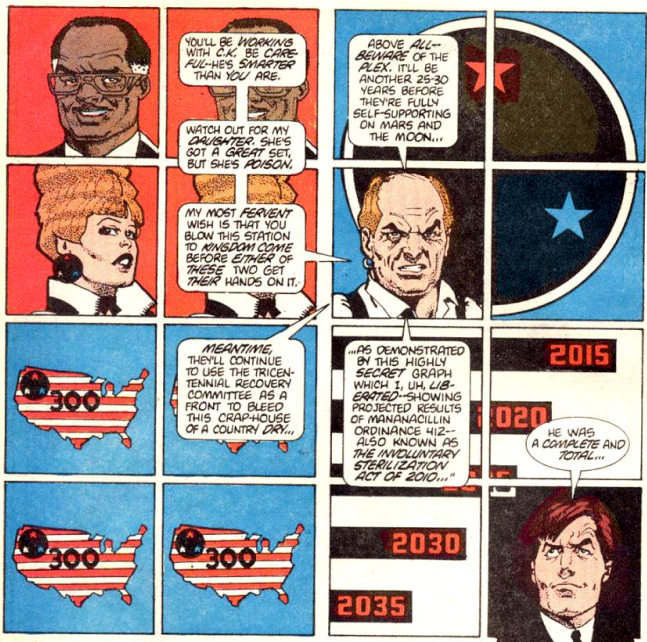
With some irony, the use of lettering is reflected in
the storyline as a plot element. The radicals are inserting subliminal
messages into the video show Bob Violence. This has the effect to
setting them off on a riot. The subliminals themselves, are draw almost
identically to the broad lettering through the book. It is almost as if
Chaykin is sharing with the reader an open joke that he is using
lettering to the same affect as the radicals.
Here we can compare them side by side, first the "real world" of Plexmall Chicago,
and then Bob Violence with subliminals:
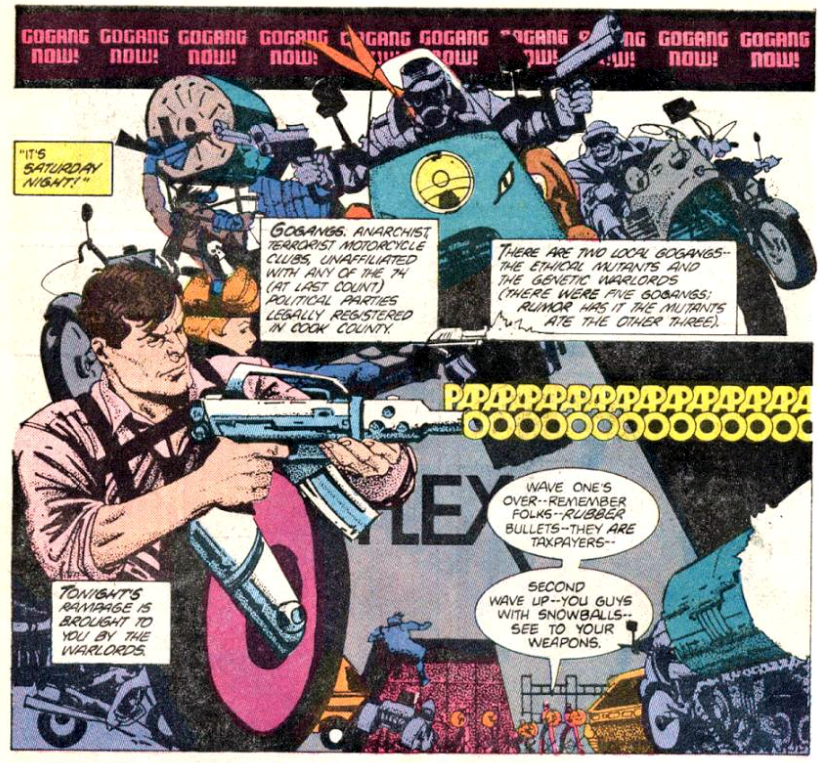 ||
||
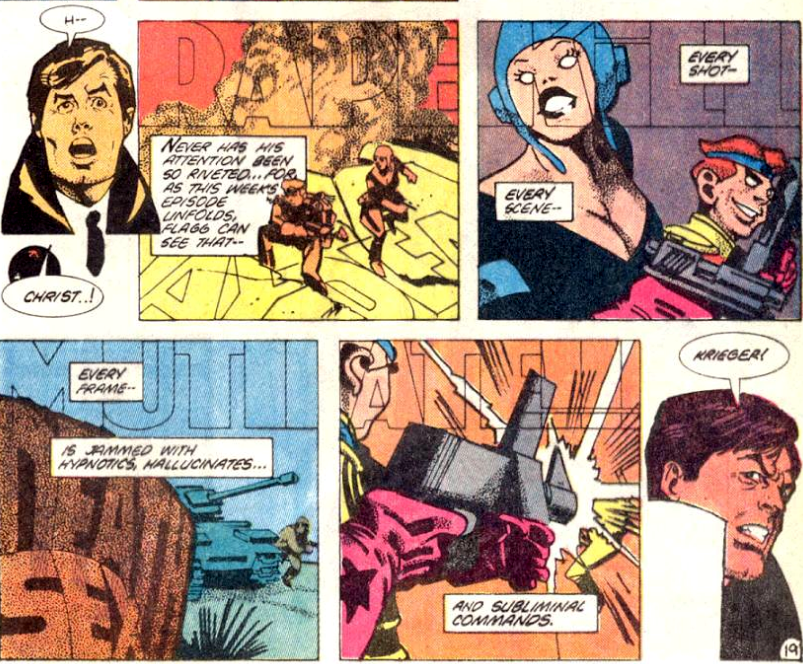
Chaykin made wide use of Craftint
Duoshade illustration boards for American Flagg!, which in the period
before computers, enabled him to add shaded textures to the finished
art. Ken Bruzenak's lettering and logowork also won notice, as it was
integral to American Flagg's futuristic, trademark-littered ambiance.
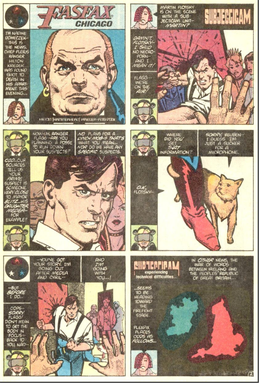
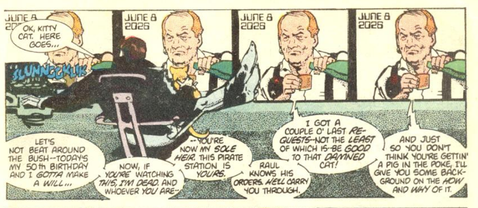
Confused yet? That is, partly the point. Chaykin's art inundates the
reader with huge quantities of raw, unfiltered information. Characters
talk over television screens, advertisements and sound effects,
to the extent that the reader does not know what to read first.
Published between 2004 and 2006, Solo was a DC Comics anthology series with an innovative twist: each issue was created from the ground up by a single cartoonist and collaborators of his own choosing. Edited by DC's head art director Mark Chiarello (Wednesday Comics, DC: The New Frontier), the series offered artists a platform to control their visions completely in the form of original stories, unfettered access to DC's library of characters, and without regard to continuity or other publishing concerns that affect the creation of a typical DC superhero book. Although Solo spotlighted the work of such talented and popular creators as Darwyn Cooke, Tim Sale, Paul Pope and Michael Allred, the series was cancelled after just 12 issues.